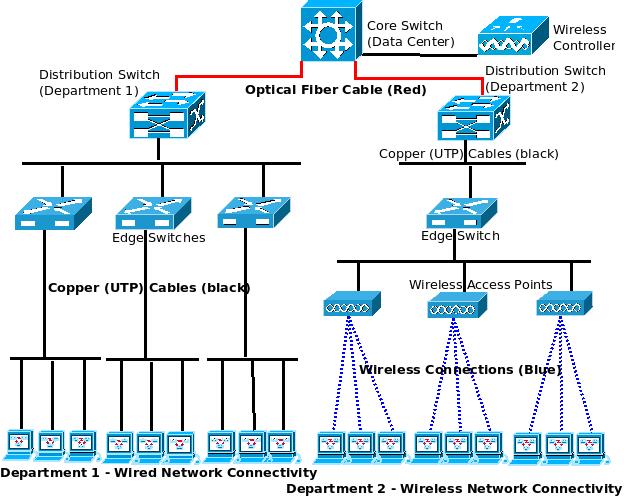Can a Wireless Network eliminate a Wired Network completely?
Implementing a wireless network does not mean that a wired network can be completely eliminated – At best, it can reduce the edge switches/ switch ports and cables/ passive components. In this post, let us try to understand what components are reduced and what components are added to a network, when a wireless network is implemented.
 To illustrate the point, let us compare the components used in wired and wireless networks in an enterprise/ organization.
To illustrate the point, let us compare the components used in wired and wireless networks in an enterprise/ organization.
Let us assume that there is an organization with two departments – Department 1 (All Computers connect using the wired network) & Department 2 (All computers connect using the wireless network) – Connectivity and Components for both wired and wireless networks are shown in the above diagram, for each department.
Department 1 is fully wired. So, all the computers are directly connected to the edge switch ports in that department using Cat 5/6/7 Copper UTP cables. Department 2 is fully wireless. So, all the computers connect (over the air) to the access points. Both the edge switches and the access points connect to the distribution switches of their respective departments.
In turn, these distribution switches connect to the core switch (In the data center) using Optical Fiber Cables (Mostly). For the wireless network, there is a wireless controller (which connects mostly to the core switch) for centralized management of all the access points.
For simplicity, three computers are shown connecting to each edge switch, but let us assume that 15 computers connect to each switch/ access point. So, 3=15, in our diagram!
Wired Vs Wireless Network (Analysis):
So, now let us go to the analysis. The wired network should be rather straight forward to understand, from the diagram. When we consider the wireless network (Department 2), let us list down the changes from the wired network (below):
- In place of three edge switches for the wired network, there is only one edge switch for the wireless network.
- There are three wireless access points to connect all the computers over the wireless medium in the wireless network.
- The individual cables that go to each computer (and hence the other passive components) has reduced in the wireless network because, the cables only go to the access points, and not individual computers.
- Laptops can connect directly to the wireless network with built-in wireless adapters. But in case of computers, additional wireless cards for each computer is required (either internal or external) for wireless network connectivity.
- There is a wireless controller introduced in the wireless network (connected to the core switch) which provides centralized management to the wireless access points.
- The core switch, distribution switches, cables and all other components are same for both wired and wireless network.
So, in conclusion, we can say that a wireless network replaces the wired connectivity in the network edge (where end users connect to the network). The backbone network components (Inter department fiber connections, distribution switches, core switch, firewalls, routers, etc) are the same for both wired and wireless networks.
What about the cost comparison (between wired and wireless networks)?
Think about what we saving by implementing a wireless network in the network edge – The copper UTP cables connecting to individual computers, passive components required for each cable & edge switches/ switch ports.
But also think about the additional cost incurred by introducing the wireless network – Wireless Controller, Wireless Access Points, POE enabled switches (Or electrical power) to each access point & Wireless Adapters (For Computers, not for Laptops).
On a rough estimate, setting up of a wireless network could still cost up to 60-75% of cost incurred in building a fully wired network (Wireless Controllers are quite expensive!), in its place. This is only a rough estimate, and the cost varies based on the deployment conditions.
Except educational institutions and hospitality segment customers (who might prefer a wireless network), most of the customers might prefer the wireless network to be an overlay on the wired network – All the computers connecting to wired network, and the laptops and other guest/mobile devices connecting on the wireless network.
But ever since the wireless controllers have been introduced, some companies have gone fully wireless for their network-edge connectivity requirements. Besides, some devices like printers, specialized industrial equipments etc, require wired network ports.
There are some alternatives like Wireless Mesh Networks & High Power Wireless Radios/ Access Points which reduces the cables and passive components required at the network edge even further, but they are not as popular as the wireless controller based implementations (for larger Wi-Fi based implementations).
So, what about you? What do you think is better? Just a wired network, just a wireless network (on the network edge) (or) an overlay of wired and wireless networks?
excITingIP.com
Related Article: Everything you want to know about Wireless (Wi-Fi) Network
You could stay up to date on the various computer networking / related IT technologies by subscribing to this blog with your email address in the sidebar box that says, ‘Get email updates when new articles are published’
hi I want to receive mail